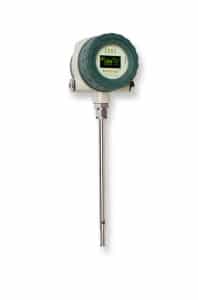Many flow technologies can be used to measure gas flow. In part four of this series on combustion efficiency, we identify various flow technologies, particularly mass flow meters and differential pressure flowmeters. While these meters are suitable for measuring natural gas flow, most technologies are not ideal for combustion air flow measurement because of the higher volumes typical for combustion air and the larger duct sizes.
Flow Meters

Coriolis flow meters provide a direct mass flow measurement based upon the fluid’s deflection force moving through a vibrating tube. These meters are highly accurate with high turndown capabilities and are independent of fluid properties. They are also expensive to purchase and install and are not suitable for larger pipe sizes.
Positive Displacement meters require fluid to mechanically displace components and measure volumetric flow at the operating pressure and temperature. While they have acceptable accuracy, pressure and temperature compensation would be needed to achieve mass flow, and since they have moving parts, gas cleanliness is important.
Thermal Mass flow meters measure the mass flow based on heat transfer from a heated element. The measurement is in mass flow, and additional pressure and temperature correction are not required. They also provide excellent accuracy and repeatability and are easy to install.
Turbine Flow meters measure volumetric flow based on fluid flowing past a free-spinning rotor, each revolution corresponding to a specific volume of fluid. The meters have high turndown and accuracy. Unfortunately, the meter’s service is limited to clean dry gases because of the moving parts, and pressure and temperature compensation are necessary.
Ultrasonic Flow meters measure the difference in transit time of pulses that move from a downstream transducer to the upstream transducer, compared to the time from the upstream transducer back to the downstream transducer. This meter style is exceptionally accurate but very expensive and additionally requires pressure and temperature measurement.
Vortex Flowmeter has a bluff object or shedder bar placed in the flow path, and as gas flows around the shedder bar, vortices are cyclically generated from opposite sides of the bar. The frequency of vortex generation is a function of the gas velocity. The frequency of vortex shedding is independent of the fluid composition. However, the meter requires pressure and temperature compensation and demands a minimum flow rate to produce vortices.
Differential Pressure Meters
Differential pressure flow meters calculate flow by measuring pressure drop over an obstruction inserted in the flow path. Common types of flow elements are orifice plates, flow nozzles, venturi tubes, and averaging pitot tubes. This technology is used for natural gas flow and combustion air flow.
An orifice Plate is a differential pressure meter frequently used for natural gas measurement. It measures volumetric flow, not mass flow. This meter’s limitations include: poor low flow sensitivity, limited turndown, creates a pressure drop impacting operating costs, and requires correction of pressure and temperature to obtain mass flow.
Averaging Pitot Tube is a differential-pressure flow measurement device commonly used for combustion air measurement. The instrument has limitations with the gas flow, especially low flow sensitivity and turndown. The measure is contingent upon achieving velocity pressure, and it is possible to have insufficient momentum to obtain an acceptable signal at low flow rates.
For combustion air flow measurements, other flow elements or obstructions have been used; these include measuring the pressure drop across an elbow in the ductwork, across a venturi built into the duct, or even across turning vanes in the duct.
Combustion Air Flow Measurement
While many flow technologies excel in natural gas measurement, they do not excel in combustion air flow measurement. In part five, the final section of this series reveals that thermal mass flow meters are ideally suited for both natural gas flow and combustion airflow measurement.
If you are interested in reading this article in full, see the Sage Metering white paper, Combustion Efficiency and Thermal Mass Flow Meters.
If you are interested in learning more about other meters to measure natural gas, read more.
Perhaps this video may be of interest:
Air Fuel Ratio Effect Combustion Efficiency and Air Fuel Ratio
Air Flow Meter for Combustion Efficiency | Industrial Boilers

